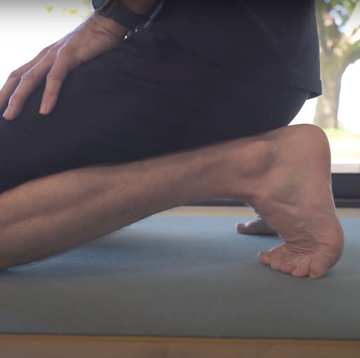One of the beauties of our sport is that you can run on just about any surface, anywhere in the world. As long as you have feet, you can train wherever you find yourself. But not all surfaces are created equal – vary your location and you’ll vary your session, because of the different impacts involved and the stresses which make their way up to your joints.
“In the summer, when I run mainly on grass, my whole body seems to relax,” said two-time world indoor champion Marcus O’Sullivan after winning a mile race. Concrete, he noticed, sent shock waves through his body and was a surefire route to long-term damage. There was only one way to sum it up: “I’m convinced that if you run on softer surfaces, your career will last longer.”
The 35-year-old Irishman is still mixing it with the world’s top milers, and many other runners have noticed that they feel different, physically and psychologically, when they run on different surfaces. And while running-surface preferences are something of an individual matter, varying from runner to runner just like favourite shoes, the following guide will clear up the merits of the various alternatives so that you can make the very best of what’s available to you.
The best surfaces to run on - grass
At its best, the grassland of parks, golf courses and football pitches provides the purest, most natural surface for running. Areas where sheep graze are often home to fine, close-cropped turf, too.
Pros: While grass is soft and easy on the legs in terms of impact, it actually makes your muscles work hard. This builds strength and means you’ll notice the difference when you return to the road. When it’s flat, it provides an excellent speedwork surface (spikes may be necessary in wetter conditions) and, unlike a track, can give you space to run whole repetitions without having to make tight turns.
Cons: Most grassland is uneven and can be dangerous for runners with unstable ankles. It can also be slippery when wet, runners with allergies may suffer more symptoms when running on it, and its softness can tire legs surprisingly quickly. Finally, of course, while the very best grass for running is often found on bowling greens and golf courses, the owners are not always happy to discover runners on their hallowed turf.
Conclusion: If you can find a flat, even stretch of it, grass is the best training surface for most runners, especially as you get older.
Rating: 9.5/10
The best surfaces to run on - woodland trails
For a run that mixes constantly-changing surroundings with near-ideal running surfaces, head for your local woodland. Soft peat is God’s gift to runners, trails are usually quite level, and in some forests they go on for miles. They can sometimes be rather muddy, though.
Pros: Usually easy on the legs and located in scenic areas that make you keen to return.
Cons: Unless you’re lucky enough to find wood chips or well-drained peat, woodland trails can be muddy and slippery. Tree roots can be a hazard for unwary runners.
Conclusion: Woodland trails can be a bit of a mixed bag in terms of quality, though the odds are usually in your favour. A wood-chip trail through a huge forest is the ultimate runner’s treat, though these are found in greater abundance in Finland than in Britain.
Rating: 9/10
The best surfaces to run on - earth
This heading covers a wide spectrum of trails, from the worn-out routes across playing fields to the winding tracks heading out into the back of beyond. There’s a point at which an ideal trail becomes too muddy or too hard-baked to be of much real benefit, but in practical terms, you can’t go far wrong with good old accessible dirt.
Pros: The medium to soft surfaces decrease the risk of overuse injuries and reduce impact on downhills. Bare earth trails are often in inspirational settings with shade in the summer.
Cons: Wet, slippery mud is very hard to run on and increases your risk of injury – especially to calves and Achilles tendons. Also, as you get further away from civilisation, the surfaces are likely to become rougher, making twisted ankles more likely.
Conclusion: One of the best surfaces to run on, though sometimes difficult for the city-based runner to find.
Rating: 8/10
The best surfaces to run on - cinders
This gritty composition of fine rock, carbon, ash and slag made up the running tracks of the pre-synthetic era. A few of them are still around, and you can also find cinder paths in some town parks.
Pros: Cinders are much easier on the legs than roads are. If they’re well-maintained, they can provide a good, even surface, and a track has the obvious advantage of being of an exactly-measured distance.
Cons: Cinders certainly don’t provide an all-weather surface! In the heat they become loose and slippery, and in the rain they can turn into a quagmire. Loose cinders can also create slight slippage underfoot.
Conclusion: As all-weather surfaces grow in popularity, cinder tracks are few and far between. If they’re well-kept, though, they’re still one of the most comfortable surfaces to run on.
Rating: 7.5/10
Back pain from running? This could be why
Nowadays, almost all British tracks are made of modern synthetic materials. While most people think of them purely as fast surfaces for fast runners, they’re more versatile than that.
Pros: Synthetic tracks provide a reasonably forgiving surface and, being exactly 400 metres around, make measuring distances and timing sessions easy.
Cons: With two long curves on every lap, ankles, knees and hips are put under more stress than usual. Longer runs also become very tedious.
Conclusion: Tracks are ideal for speedwork, but you have to be dedicated to use them for anything else.
Rating: 7/10
The best surfaces to run on - treadmill
When the weather’s bad, a treadmill is the best indoor running option for most runners (well, it beats running on the spot in your living room). Most treadmills have monitors that display incline, pace, heart rate, calories burned and other data. The hardness of the running surface varies between machines – some are far softer than others.
Pros: The smooth surface is generally easy on the legs, and hitting a desired pace is simply a matter of adjusting the machine (as long as you can keep up!). Additionally, you don’t have to worry about external factors such as dogs, wind and bad weather. The precise level of control makes a treadmill ideal for speedwork.
Cons: Effectively running on the spot isn’t very exciting, and if you don’t concentrate on keeping up your pace, you could be unceremoniously dumped behind the machine. Without the benefit of a natural breeze, treadmill runners tend to sweat profusely. The machines are too expensive for most individual runners, and gym membership may be uneconomical if you just go there to run.
Conclusion: Not everyone’s cup of tea, but fine if you live in an inner-city area with few trails, little grass and freezing weather. Also good for rural runners when the days are short, and for runners who find it hard to keep up a steady pace.
Rating: 6.5/10
The best surfaces to run on - asphalt
Asphalt is the mixture of gravel, tar and crushed rock that makes up 95 per cent of Britain’s roads. It isn’t the softest surface around, but it’s difficult to avoid and it’s better than concrete.
Pros: As all road-runners know, asphalt is one of the fastest surfaces you can find, it’s easy to measure distances on it, and it’s simple to keep up a steady rhythm. While it’s rather solid, it’s a predictable, even surface that puts less strain on the Achilles tendon than softer or uneven terrains.
Cons: You face cambers, pot-holes, traffic and a pretty unforgiving surface that does put a strain on the body.
Conclusion: Though it’s a hard surface to run on, asphalt is also one that’s hard to stay away from. If you intend to race on it, some training (but not much) on it is advisable.
Rating: 6/10
The best surfaces to run on - sand
Sand offers a run with a real difference. If it’s dry and deep, you can give your calf muscles the work-out of their life without risking any impact damage to your joints. If you’re on the beach, you get the sea breeze and the surroundings as a bonus, and if you don’t fancy the dunes, you can choose the relatively firm strip by the water’s edge as a brisker alternative.
Pros: Sand gives an opportunity to run barefoot in an pleasant environment. Running through dunes provides good resistance training and strengthens the legs.
Cons: Despite being great for building leg strength, the softness of the sand means a higher risk of Achilles tendon injury. Also, though the sand is firmer at the water’s edge, the tilt of the surface puts uneven stresses on the body. And while it’s tempting to run barefoot, watch out for blisters.
Conclusion: Flat, firm sand can be a near-perfect running surface, but most beaches have cambers and any uneven footing can overstress muscles. It’s probably best to limit runs on sand to shorter distances.
Rating: 6/10
The best surfaces to run on - concrete
Concrete is primarily made up of cement (crushed rock), and it’s what most pavements and five per cent of roads are constructed from. It delivers the most shock of any surface to a runner’s legs.
Pros: Concrete surfaces tend to be easily accessible and very flat, and if you stick to pavements, you can avoid traffic.
Cons: The combination of a hard surface (reckoned to be 10 times as hard as asphalt), kerbs, and the need to sidestep pedestrians, can lead to injury.
Conclusion: City dwellers probably have little choice but to do a large proportion of their running on concrete. If you get the slightest opportunity, though, look for softer surfaces.
Rating: 2.5/10
The best surfaces to run on - snow
If you live in Britain, you won’t generally have many opportunities to run on snow. That’s just as well, for where there’s snow, there’s usually ice too.
Pros: Snow can convert a drab park into a winter wonderland, giving you a sense of adventure as you tread through a freshly fallen snowfall. It also forces a slow pace, which is excellent for muscles recovering from injury.
Cons: Once broken, snow can be slippery, and slush, ice and frozen footprints make the going even more unpredictable. Snow can hide dangerous objects and cause muscle fatigue, and as well as increasing your risk of injury, it’s also bad for your shoes.
Conclusion: Initially a pleasant change, but the feeling doesn’t usually last.
Rating: 2/10














